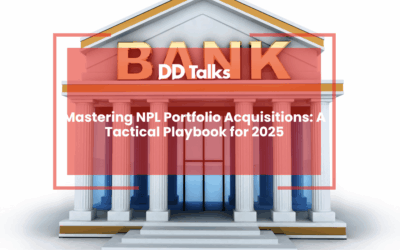Essential Insights for NPL Investment Success
- The European NPL market presents significant opportunities with approximately €300 billion in transactions since 2015, with Southern European countries leading but emerging markets in Central and Eastern Europe gaining traction.
- Successful NPL investment strategies vary by risk appetite and expertise: “buy and hold” (5-7 year horizon), “trade and flip” (shorter-term), or specialization by asset class (residential: 8-12% IRR; commercial: 15-20% IRR; unsecured consumer: 20-25% IRR).
- Effective portfolio sourcing requires developing direct bank relationships, investment banking connections, and market intelligence networks to access deals before competitive auctions.
- Comprehensive due diligence across financial, legal, operational, and servicing dimensions is essential, with particular attention to data integrity, collateral valuation, and documentation quality.
- NPL valuation typically combines discounted cash flow analysis (using 12-25% discount rates), scenario modeling, comparable transaction analysis, and increasingly, statistical approaches using machine learning.
- Risk management must address execution, legal/regulatory, funding/liquidity, reputational, and concentration risks through specialized expertise and robust operational frameworks.
- Performance measurement should track multiple metrics including IRR (12-25% target), MOIC (1.4x-2.5x target), collection curves, cost-to-collect ratios (15-40%), and resolution timelines.
- Building effective NPL investment capabilities requires specialized teams combining financial, operational, and legal expertise, supported by robust technology infrastructure and strategic servicing partnerships.
Table of Contents
- Understanding the European NPL Market Landscape
- Key NPL Investment Strategies for Institutional Players
- How to Source High-Quality NPL Portfolios
- Conducting Effective Due Diligence on NPL Assets
- Valuation Methodologies for Distressed Debt Portfolios
- Managing Risks in NPL Investments
- Optimizing Returns: Performance Metrics That Matter
- Building Your NPL Investment Team and Infrastructure
Understanding the European NPL Market Landscape
The European non-performing loan (NPL) market has evolved significantly over the past decade, presenting unique opportunities for institutional and private investors alike. With approximately €300 billion in NPL transactions since 2015, the market continues to demonstrate resilience despite economic fluctuations.
Southern European countries—Italy, Spain, Greece, and Portugal—remain the most active NPL markets, with Italy alone accounting for over €130 billion in transactions. However, emerging opportunities in Central and Eastern European countries are gaining traction as banks across the region face regulatory pressure to clean up their balance sheets.
The NPL ratio—the proportion of non-performing loans to total loans—varies significantly across Europe. While the European Banking Authority reports an average NPL ratio of approximately 2.3% across the EU, individual countries show considerable variation, with Greece and Cyprus still maintaining double-digit ratios despite significant reductions.
Regulatory frameworks continue to shape the market, with the European Central Bank’s NPL guidelines and the EU’s NPL Action Plan driving banks to accelerate disposals. The introduction of standardised NPL data templates has improved transparency, while national asset management companies (AMCs) in countries like Ireland, Spain, and more recently, Greece have played pivotal roles in market development.
Key NPL Investment Strategies for Institutional Players
Successful NPL investors employ diverse strategies tailored to their expertise, risk appetite, and capital structure. Portfolio acquisition strategies typically fall into several categories, each requiring specific capabilities and offering different risk-return profiles.
The “buy and hold” approach involves acquiring NPL portfolios at significant discounts to face value and patiently working through the resolution process. This strategy requires deep operational expertise and typically yields returns over a 5-7 year horizon. In contrast, the “trade and flip” strategy focuses on shorter holding periods, with investors seeking to add value through initial restructuring before selling to longer-term holders.
Specialisation by asset class represents another strategic dimension. Residential mortgage NPLs offer relatively predictable cash flows but lower returns, typically 8-12% IRR. Commercial real estate NPLs present higher complexity but potentially greater returns (15-20% IRR), while unsecured consumer NPLs require industrial-scale servicing capabilities and typically yield 20-25% IRR for well-executed portfolios.
Geographic specialisation has proven particularly effective for investors who develop deep local networks and jurisdiction-specific expertise. The legal frameworks governing foreclosure, bankruptcy, and debt collection vary dramatically across European countries, creating significant advantages for specialists. For example, foreclosure timelines range from under one year in some Nordic countries to over four years in Italy and Greece.
Joint ventures with originating banks have emerged as an increasingly popular strategy, particularly for larger portfolios. These structures allow banks to maintain relationships with borrowers while transferring risk and leveraging investor expertise in NPL workout approaches.
How to Source High-Quality NPL Portfolios
Effective NPL deal sourcing requires a multi-faceted approach combining relationship development, market intelligence, and strategic positioning. The most successful investors develop proprietary sourcing channels rather than relying exclusively on widely-marketed transactions.
Direct relationships with banks remain the gold standard for NPL sourcing. Establishing credibility with financial institutions as a reliable counterparty who can execute transactions efficiently creates opportunities for bilateral deals, which typically offer better economics than competitive auctions. This approach requires patience and investment in relationship management but yields significant advantages in deal flow and pricing.
Investment banks and specialised advisors represent another critical sourcing channel, particularly for larger portfolios. These intermediaries often have visibility into upcoming transactions before formal marketing begins. Developing relationships with key individuals at these firms can provide early access to deal information and, in some cases, influence transaction structuring.
Market intelligence networks are increasingly important as the NPL ecosystem has matured. Servicers, law firms, and other service providers often have visibility into potential transactions before they reach the market. Cultivating these relationships can provide valuable early signals of portfolio availability.
Regulatory developments also create sourcing opportunities. Monitoring supervisory actions, stress test results, and changes to capital requirements can identify banks likely to accelerate NPL disposals. Similarly, understanding the strategic priorities of national asset management companies provides insights into potential future transactions.
Conducting Effective Due Diligence on NPL Assets
Rigorous due diligence forms the foundation of successful NPL investing, with the process varying significantly based on asset class, jurisdiction, and portfolio size. A comprehensive approach typically encompasses financial, legal, operational, and servicing dimensions.
Loan-level data analysis represents the core of financial due diligence. Investors must verify data integrity, identify missing information, and assess key parameters including loan-to-value ratios, payment histories, and borrower profiles. Advanced investors employ sampling techniques and statistical approaches to manage the analysis of large portfolios, often using machine learning to identify patterns and anomalies.
Collateral valuation requires particular attention, especially for secured NPLs. This process involves reviewing property valuations, conducting site visits for significant assets, and applying appropriate haircuts based on market conditions and liquidity. Sophisticated investors develop proprietary valuation models calibrated to specific micro-markets and asset types.
Legal due diligence focuses on enforceability of claims, documentation quality, and jurisdiction-specific considerations. This includes reviewing loan agreements, security documents, and enforcement proceedings. Particular attention must be paid to potential defects in loan documentation that could impair collection rights or extend resolution timelines.
Servicing capabilities assessment has gained importance as investors recognise that execution quality dramatically impacts returns. This includes evaluating existing servicers or developing transition plans to preferred partners. Key considerations include technological capabilities, staffing levels, performance track record, and alignment of incentives.
Valuation Methodologies for Distressed Debt Portfolios
NPL portfolio valuation requires sophisticated approaches that account for the unique characteristics of distressed assets. While multiple methodologies exist, most investors employ a combination of approaches to develop robust valuation frameworks.
Discounted cash flow (DCF) analysis remains the foundation of NPL valuation. This approach projects expected collections over time, incorporating assumptions about resolution strategies, timelines, and costs. The resulting cash flows are then discounted at rates reflecting the risk profile of the portfolio, typically ranging from 12% to 25% depending on asset class, jurisdiction, and quality.
Scenario analysis enhances DCF models by incorporating multiple potential outcomes. Sophisticated investors develop base, upside, and downside cases with different assumptions regarding collection rates, timelines, and costs. These scenarios are then probability-weighted to derive an expected value, providing a more nuanced view of risk-return dynamics.
Comparable transaction analysis serves as an important reference point, particularly in active markets with transparent pricing. This approach examines recent transactions with similar characteristics, adjusting for differences in portfolio composition, quality, and market conditions. Key metrics include price-to-face-value ratios, price-to-UPB (unpaid principal balance) ratios, and implied collection multiples.
Statistical valuation approaches have gained prominence with the growth of data availability and analytical capabilities. These methods leverage historical performance data to develop predictive models of collection outcomes. Machine learning techniques can identify patterns in borrower behaviour and asset performance that enhance prediction accuracy.
Managing Risks in NPL Investments
NPL investing entails multifaceted risks that require sophisticated management approaches. Successful investors develop comprehensive frameworks to identify, quantify, and mitigate these risks throughout the investment lifecycle.
Execution risk—the potential for collections to fall short of projections—represents the most significant challenge. This risk manifests in multiple dimensions, including longer-than-expected resolution timelines, lower recovery rates, and higher servicing costs. Mitigating execution risk requires robust operational capabilities, experienced servicing teams, and continuous performance monitoring with adaptive management approaches.
Legal and regulatory risks vary significantly across jurisdictions and require specialised expertise. Changes to foreclosure procedures, borrower protection laws, or tax treatments can dramatically impact investment returns. Leading investors maintain dedicated legal teams with jurisdiction-specific expertise and actively monitor legislative developments that could affect their portfolios.
Funding and liquidity risks must be carefully managed, particularly for longer-duration investments. Mismatches between investment horizons and funding structures can create significant vulnerabilities during market disruptions. Sophisticated investors develop diversified funding sources with staggered maturities and maintain appropriate liquidity buffers.
Reputational risk has gained prominence as NPL investors face increasing scrutiny regarding borrower treatment. Aggressive collection practices can generate negative publicity and regulatory attention. Leading investors develop responsible servicing guidelines, emphasising sustainable restructuring solutions where viable and ensuring fair treatment throughout the resolution process.
Concentration risk emerges when portfolios have excessive exposure to specific borrowers, asset types, or geographic regions. Diversification strategies and exposure limits help mitigate these risks, though they must be balanced against the benefits of specialisation and local expertise.
Optimizing Returns: Performance Metrics That Matter
Effective performance measurement is essential for NPL investment success, with sophisticated investors employing multiple metrics to evaluate returns, identify improvement opportunities, and guide strategic decisions.
Internal Rate of Return (IRR) serves as the primary performance metric for most NPL investors, capturing the time value of money and enabling comparison across investments with different durations and cash flow patterns. Target IRRs typically range from 12-15% for lower-risk secured portfolios to 20-25% for higher-risk unsecured assets. Leading investors calculate both gross and net IRRs, with the latter accounting for all fees, expenses, and carried interest.
Multiple on Invested Capital (MOIC) provides a complementary perspective, measuring the total return relative to capital deployed without considering the timing of cash flows. Successful NPL investments typically target MOICs of 1.4x to 2.5x depending on asset class and risk profile. This metric is particularly valuable for assessing the absolute return generated by an investment.
Collection curves track actual recoveries against projections over time, serving as early indicators of performance. Sophisticated investors develop detailed collection forecasts by asset type and resolution strategy, then monitor variances to identify emerging issues and opportunities. Persistent underperformance relative to the collection curve often signals the need for strategy adjustments.
Cost-to-collect ratios measure operational efficiency by comparing servicing and resolution costs to amounts recovered. These ratios typically range from 15-20% for secured portfolios to 30-40% for unsecured consumer debt. Tracking these metrics over time helps identify operational improvements and benchmark performance against industry standards.
Resolution timelines track the speed at which assets move through the workout process, with faster resolutions generally improving returns. Leading investors monitor average resolution times by asset type and jurisdiction, identifying bottlenecks and implementing process improvements to accelerate cash flow generation.
Building Your NPL Investment Team and Infrastructure
Successful NPL investing requires specialised capabilities and infrastructure that differ significantly from traditional fixed-income or real estate investment platforms. The most effective organisations combine financial expertise with operational capabilities and jurisdiction-specific knowledge.
Core team composition typically includes investment professionals with backgrounds in distressed debt, real estate, and structured finance. These individuals lead deal sourcing, valuation, and transaction execution. Equally important are workout specialists with experience in loan restructuring, foreclosure processes, and asset management. Legal experts with jurisdiction-specific knowledge round out the core team, providing critical insights on enforcement strategies and regulatory considerations.
Technology infrastructure has become increasingly important as portfolio sizes grow and data-driven approaches gain prominence. Leading investors develop or acquire specialised loan management systems that track portfolio performance, monitor workout progress, and generate actionable insights. Data analytics capabilities enable more sophisticated valuation approaches and help identify optimal resolution strategies for different borrower segments.
Servicing partnerships represent a critical strategic decision. Some investors build in-house servicing platforms to maintain control over borrower interactions and resolution strategies. Others develop relationships with specialised third-party servicers, selecting partners based on asset class expertise, geographic coverage, and performance track record. Hybrid approaches are increasingly common, with investors maintaining core servicing capabilities while leveraging external partners for specific functions or jurisdictions.
Knowledge management systems help organisations capture and disseminate learnings across portfolios and over time. These systems document successful resolution strategies, jurisdiction-specific insights, and process improvements. Leading investors create feedback loops between investment and servicing teams, ensuring that execution experiences inform future acquisition decisions.
Governance frameworks establish clear decision-making processes, risk management protocols, and performance monitoring approaches. These structures typically include investment committees, risk oversight functions, and regular portfolio reviews. Well-designed governance ensures accountability while providing teams with appropriate autonomy to execute resolution strategies efficiently.
Frequently Asked Questions
What are NPLs and why are they important investment opportunities?
Non-performing loans (NPLs) are loans where borrowers have stopped making scheduled payments for a specified period (typically 90+ days). They represent significant investment opportunities because banks sell these assets at discounts to face value to clean up their balance sheets. For investors with specialized expertise, these discounted purchases can yield attractive returns through effective workout strategies and resolution processes.
Which European countries have the most active NPL markets?
Southern European countries—specifically Italy, Spain, Greece, and Portugal—maintain the most active NPL markets in Europe. Italy leads with over €130 billion in transactions since 2015. However, Central and Eastern European countries are emerging as growth markets as banks across the region face increasing regulatory pressure to reduce non-performing exposures on their balance sheets.
What returns can investors expect from NPL investments?
NPL investment returns vary by asset class and risk profile. Residential mortgage NPLs typically yield 8-12% IRR with relatively predictable cash flows. Commercial real estate NPLs offer higher complexity but potentially greater returns of 15-20% IRR. Unsecured consumer NPLs require industrial-scale servicing capabilities but can generate 20-25% IRR for well-executed portfolios. Target MOICs (Multiple on Invested Capital) typically range from 1.4x to 2.5x.
What are the key risks in NPL investing?
The primary risks in NPL investing include: execution risk (collections falling short of projections), legal and regulatory risks (varying significantly across jurisdictions), funding and liquidity risks (particularly for longer-duration investments), reputational risk (regarding borrower treatment), and concentration risk (excessive exposure to specific borrowers, asset types, or regions). Successful investors develop comprehensive frameworks to identify, quantify, and mitigate these risks throughout the investment lifecycle.
How important is servicing strategy to NPL investment success?
Servicing strategy is critical to NPL investment success as execution quality dramatically impacts returns. Investors must decide whether to build in-house servicing platforms, develop relationships with specialized third-party servicers, or implement hybrid approaches. Key considerations include technological capabilities, staffing levels, performance track record, and alignment of incentives. Cost-to-collect ratios (typically 15-40% depending on asset type) and resolution timelines are important metrics for measuring servicing effectiveness.
What due diligence is required before purchasing NPL portfolios?
Comprehensive NPL due diligence encompasses financial, legal, operational, and servicing dimensions. Key components include: loan-level data analysis to verify integrity and assess key parameters; collateral valuation with appropriate market-based haircuts; legal review of loan documentation and enforcement rights; and assessment of servicing capabilities. The process varies significantly based on asset class, jurisdiction, and portfolio size, with sophisticated investors often employing sampling techniques and statistical approaches for large portfolios.
How has regulation shaped the European NPL market?
Regulatory frameworks have significantly shaped the European NPL market. The European Central Bank’s NPL guidelines and the EU’s NPL Action Plan have driven banks to accelerate disposals. The introduction of standardized NPL data templates has improved transparency and transaction efficiency. National asset management companies (AMCs) in countries like Ireland, Spain, and Greece have played pivotal roles in market development by absorbing large volumes of distressed assets and establishing pricing benchmarks.




0 Comments